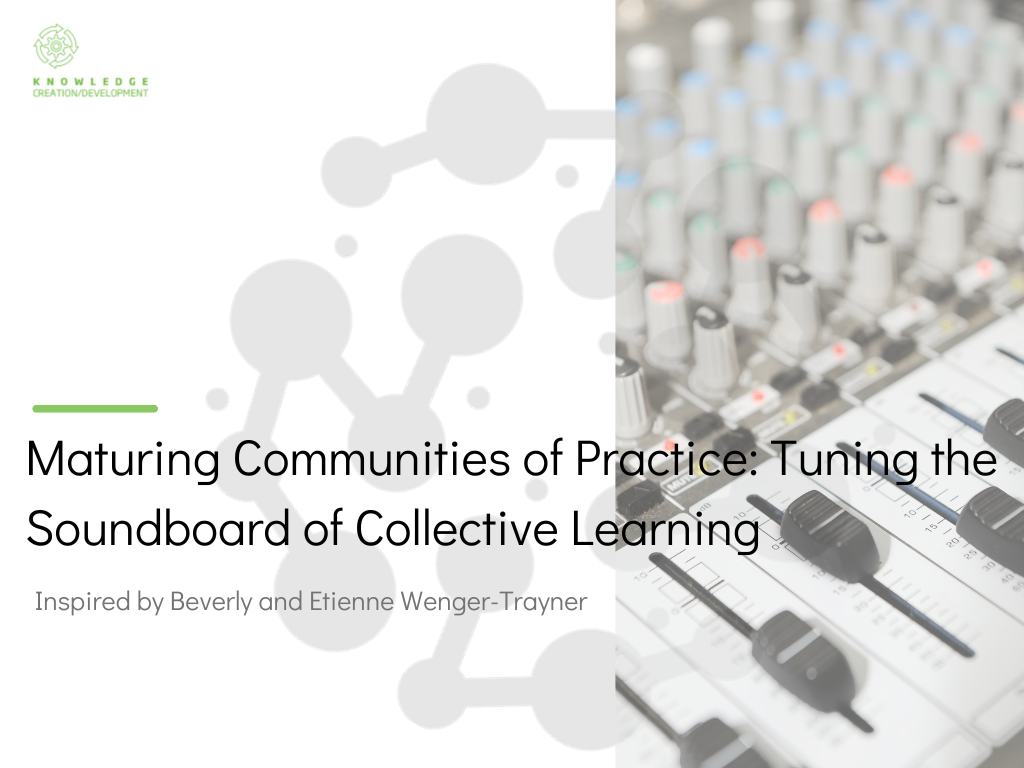
Maturing Communities of Practice: Tuning the Soundboard of Collective Learning
Introduction: What Are Communities of Practice (CoPs)?
A Community of Practice (CoP) is more than a working group or interest circle. It is a dynamic, evolving group of people who share a concern, a set of problems, or a passion about a topic and deepen their knowledge and expertise by interacting on an ongoing basis. CoPs are built on mutual engagement, a shared domain of interest, and a repertoire of practices.
They form organically or can be intentionally cultivated. In either case, CoPs enable social learning, support knowledge sharing, and create space for collaborative problem-solving. CoPs have been adopted across sectors — from education and healthcare to NGOs, corporate environments, and public administration — as effective vehicles for capability development and innovation.
To explore more about the foundational ideas and practices, see the Wenger-Trayners’ CoP Guidebook and related reflections on Building and Growing Communities of Practice.
Context: Why Focus on the Maturity of a CoP?
While CoPs often emerge naturally, their long-term impact depends on intentional development. Many communities plateau or lose momentum without structured reflection. The maturity of a CoP is not about hierarchy or time — but about the depth of relationships, clarity of purpose, and effectiveness in generating value for members and the wider context.
Understanding CoP maturity allows community leaders, facilitators, and supporters to:
- Assess where the community currently stands
- Identify strengths and areas for development
- Design appropriate interventions
- Navigate tensions and trade-offs between stability and transformation
Guiding question: Is your community growing by design or drifting by default?
The Maturity Framework: Tuning the Dimensions Like a Soundboard
The maturity model introduced by Beverly and Etienne Wenger-Trayner is grounded in real-world community development and includes seven interrelated dimensions. These offer a rich structure for strategic reflection and planning:
Beverly Wenger-Trayner encourages us to imagine the model like a soundboard in a music studio: each dimension is a slider. There is no “correct” setting — and no fixed position. Communities have their own unique “sound,” which they are constantly tuning depending on context, purpose, and evolving needs.
This metaphor reminds us: maturity is not a formula — it is a living, adaptive design.
“There are no right or wrong responses — each community will sound different. And it should.” – Beverly Wenger-Trayner
1. Practice
The community’s ability to support members in their day-to-day work through learning, tools, methods, and feedback loops.
- Are we helping each other with real challenges from practice?
- Do we document and reflect on what we learn together?
2. Domain
The clarity, legitimacy, and development of the shared domain of interest.
- Have we defined our domain in a way that others can understand and connect to?
- Are we shaping and contributing to this domain in the wider world?
3. Context
The CoP’s relationship to its organizational or societal environment.
- How do we fit within our broader landscape?
- Are we building partnerships and responding to trends?
4. Community
The sense of belonging, shared norms, and pathways to deeper participation.
- Who belongs to our community, and why?
- How do newcomers integrate and grow within the group?
5. Identification
The emotional and personal connection members have with the community and its purpose.
- Do we foster strong, trusting relationships?
- Is there a shared identity and culture that supports agency?
6. Leadership
How leadership is distributed and enacted within the community.
- Who takes initiative and leads — and how is that supported?
- Do we intentionally develop new leadership capacities?
7. Self-Awareness
The community’s ability to reflect on its own learning processes and strategic direction.
- Are we aware of the value we create?
- Do we revisit and reimagine our collective goals?
Guiding question: Which dimensions are we strong in — and where do we need to grow?
Reflections from Practice: A Workshop Experience
In October 2025, members of the Ukrainian CoP Guidebook Translation Team participated in the first full-depth “Maturing CoP” workshop, hosted by the Wenger-Trayners in Portugal. The workshop offered a unique opportunity to experience the model in action — using real community cases, engaging in peer clinics, and mapping the seven dimensions with clarity and care.
Participants appreciated how the model supports both emerging and established CoPs. It provides a common language that bridges practice and strategy. As one participant noted: “It helps us see the community not as a product — but as a living process.”
Guiding question: What would change if we viewed community growth as a strategic design challenge?
Application: How Can the Maturity Model Be Used?
The CoP maturity model is a flexible tool, adaptable to different contexts. It can be applied in:
- Industry: To strengthen internal knowledge-sharing communities, innovation hubs, or cross-functional teams.
- NGOs and civil society: To support networked learning, build leadership pipelines, and scale good practices.
- Public sector: For building communities around policy domains, reform initiatives, or shared missions.
- Education and academia: To enhance peer-to-peer learning, connect researchers, or build interdisciplinary collaboration.
Use cases include:
Community self-assessment and strategy development
Leadership development and succession planning
Funding and sponsorship alignment
Evaluation of community impact
Guiding question: Where could this framework add clarity or spark growth in your context?
Summary: From CoP to Mature Learning Ecosystem
A mature Community of Practice is not simply older or bigger. It is one that has evolved in alignment with its purpose, people, and context — supported by reflection and intentional action.
The seven dimensions of maturity offer a powerful mirror and roadmap. Whether you are cultivating a grassroots learning circle or stewarding a transnational network, this framework can help you:
- Deepen collective learning
- Support leadership and identity
- Enhance strategic relevance
Final question: What is your community ready to mature into?
This article was inspired by the Community Maturity Workshop (October 2025) with Beverly and Etienne Wenger-Trayner, and supported by the Ukrainian CoP Guidebook Translation Project.


